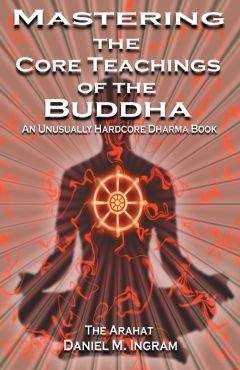Daniel Ingram - Mastering the Core Teachings of Buddha - An Unusually Hardcore Dharma Book
На электронном книжном портале my-library.info можно читать бесплатно книги онлайн без регистрации, в том числе Daniel Ingram - Mastering the Core Teachings of Buddha - An Unusually Hardcore Dharma Book. Жанр: Прочее издательство -, год 2004. В онлайн доступе вы получите полную версию книги с кратким содержанием для ознакомления, сможете читать аннотацию к книге (предисловие), увидеть рецензии тех, кто произведение уже прочитал и их экспертное мнение о прочитанном.
Кроме того, в библиотеке онлайн my-library.info вы найдете много новинок, которые заслуживают вашего внимания.

Daniel Ingram - Mastering the Core Teachings of Buddha - An Unusually Hardcore Dharma Book краткое содержание
Mastering the Core Teachings of Buddha - An Unusually Hardcore Dharma Book читать онлайн бесплатно
Beyond First Path (“What Next?”)
insight stuff shows up, the cycle begins to go around again, perhaps with more backsliding, moving forward, falling back again, remastering the old territory, more progress and suffering shows up with its associated struggles and rationalizations, then there comes a sense of there being no other option but progress and acceptance, and finally the sense that the cycle has completed itself. Soon enough there is a clear sense of a mastery stage, and so on. In this way, it may seem that some large number of paths or bhumis have been attained, twelve in the joke, when in fact they have not. Or have they? Unfortunately, this is a tough question, and one that cannot easily be resolved.
One may think that one is now at a higher stage of realization that is clearly different from before, but the “magic numbers” 4 or 10 simply may not seem to apply to one’s journey. It can also happen that, with increased clarity and progressive deepening of one’s practice, distinct progress of insight patterns may seem to be repeating within each of the smaller units of the larger pattern of the progress of insight, very much in the way of fractals, as detailed earlier. Beware! Do not get sucked into identifying with these idealized stages as actually being “where you are”!
New progress cycles and their accompanying vagueness can be very confusing if we are fixated on models but are not aware that the in-between territory is nearly impossible to successfully map in real-time.
We may sometimes feel that we have just gone through the larger progress of insight cycle when we may have actually only gone through a small part of it. We may begin to think we see first, second, third and fourth vipassana jhana aspects of each of the four larger vipassana jhanas. We may even begin to see patterns similar to those of a full progress of insight within each of the stages of the larger progress of insight or even within parts of each stage. A similar observation can arise in concentration practice with the samatha jhanas, but this tends to not be nearly as problematic or dramatic.
I have come to the conclusion that fear, anxiety, confusion, indecision and even certainty about these issues are clear markers of what needs to be investigated, i.e. those things themselves. In this way, these aspects of suffering have become trusted friends, clear signposts and red flags, as well as aspects of the goal, which is the path in the end.
The more we realize that those very processes are it, those very 257
Beyond First Path (“What Next?”)
sensations are it, the closer reality is to understanding itself. The closer reality is to understanding itself, the less fundamental suffering there is.
I have also come to the conclusion that the best reason to take these detailed maps to this extreme is that eventually they become way too ridiculous and cumbersome. Thus, eventually they can be laughed at and yet make their few useful points also, while leaving us with no option but to be with reality, one aspect of which is the sensations that make up thoughts about maps. We can learn to laugh at ourselves and our deep-seated but futile desire to simplify fresh patterns of sensations and solidify them into a sense of an attainment that “we” have.
On the darker side, when we are unable to do this, unable to laugh at our deluded attempts to fix or freeze a sense of what some illusory
“we” has done or attained, the phenomena of Twelfth Path and the complexity of the territory between paths can cause considerable doubt, pain, frustration and cynicism, the flip side of which is grandiosity. The more afraid we are of not making progress, the worse these sorts of feelings can become. The more we compare our practice to the misunderstood sensations that make up the sense of “others,” the more needless suffering arises. These sensation patterns must be investigated clearly and seen as they really are, as always.
When this all ends is a subject of considerable controversy, though like an idiot I am going to take on the topic of Full Enlightenment shortly. Anyway, it should be noted that a long-term view is very helpful sometimes, particularly if it helps one just be with what is happening today. It will often not be clear which event was actually the new Arising and Passing Event or which event was really a new Path until one has the benefit of a few more months or years of practice. One may experience many strange events, state shifts, insights and profound openings, all of which can be very compelling for some period of time.
However, there tend to be just a few of these memories that, on careful reflection, stand out in the mind as being really significant and by which one can clearly mark permanent shifts in one’s fundamental relationship to the experiences of life and the world.
In the next chapter, I will lay out a number of models of awakening that involve various numbers of shifts in understanding. One may be tempted, as I foolishly have been, to count the landmark events in one’s 258
Beyond First Path (“What Next?”)
practice and try to correlate them with these models based purely on the number of them that seem to have occurred. This is a setup for trouble, so please learn from those who have leaned the hard way and do not try it, as tempting as counting paths can be. A vastly superior form of inquiry and investigation is to carefully examine anything that seems to involve a sense of a split, of a this and a that, particularly at the rate of one to ten times per second or even faster if you can pull it off. What sensations seem to be the watcher, and what sensations seem to be watched? Try to see the true nature of these sensations one by one as they occur.
It must be said that after three or four of what seem like complete insight cycles or paths it can take quite a while to get a clear sense of what subtle dualities remain. You might find yourself walking around for days to months thinking, “Dang, I’ve really got it now. I’m just seeing it no matter what happens. Cool! I might have cracked the thing!
Dude.”
Give things time and beware of assuming that you have attained to more than you have. It is a very common and embarrassing problem, but those who know this territory will understand. However, those who do not know this territory may not be so forgiving, so beware of claiming a specific level of realization, particularly final realization, however you define it, until you have carefully checked things out for a very long time. I would advise thinking along the lines of, “Well, my working hypothesis is that it seems that I have achieved whatever, but I will keep an open mind and be cautious in what I say.”
Use the descriptions of realization that follow to give yourself a general sense of the territory and what tends to need work and investigation. Avoid whenever possible the traps mentioned above, but when you realize you have fallen into them, which is ever so human and common, then accept this, learn from it and laugh! Should you realize that you have failed to heed this advice, that you have bought into some limited definition of yourself as a realized being of some defined rank or level despite the warnings, you can try to deny it for a while, that’s OK.
You can imagine that you are very sure you know “where you are,” as that sort of artificial solidification of reality is common enough. You can get pissed off at yourself, that’s normal. You can beat yourself up if you 259
Beyond First Path (“What Next?”)
think that it will help, though it rarely does. You can get bitter, though such responses tend to wear out their welcome. You can pump yourself up, dwelling on “your” imagined or real successes, though this tends to ring hollow soon enough. You can try to pretend you don’t care what stage or level you have achieved, though eventually this gives itself away.
However, when you feel you are done with these things, accept, learn and laugh! Repeat as necessary and then get back to investigating those sensations.
260
Mastering the Core Teachings of the Buddha
30.MODELS OF THE STAGES OF ENLIGHTENMENT *
Before I discuss the various models, I should begin by saying that this is almost certainly the most easily misconstrued chapter in this book. Further, if you are a big fan of standard Buddhist dogma, I strongly recommend that you stop reading this chapter now and skip to the conclusion of this book. Seriously, I’m about to get quite irreverent again, but in that irreverence are bits of wisdom that are hard to find so explicitly stated elsewhere, so dismiss this chapter at your peril.
The temptation when thinking about enlightenment is to come up with something defined that you can imagine, such as a state or quality of being, and then fixate on that ideal rather than doing the practices that lead to freedom. It is absolutely guaranteed that anything you can imagine or define as being enlightenment is a limited and incorrect view, but these views are extremely tempting just the same and generally continue to be very seductive even through the middle stages of enlightenment. Every possible description of the potential effects of realization is likely to feed into this unfortunate tendency.
Thus, my distinct preference when practicing is to assume that enlightenment is completely impractical, produces no definable changes, and has nothing whatsoever to do with the scopes of the other trainings. This means that I take it as a working hypothesis that it will not make me a better person in any way, create any beneficial mental qualities, produce any states of happiness or peace, and provide no additional clarity into any of the issues surrounding how to live my ordinary life. I have experimented with adopting other views and found that they nearly always get in the way of my insight practices.
A view so easily becomes sacred, and thus the temptation is to not investigate the sensations that make up thoughts about that view, but rather to imitate the ideal expressed in the content of that view. This can seem like practice in fundamental insight, but it is not. I realize that I am not doing a good job of advertising enlightenment here, particularly following my descriptions of the Dark Night. Good point. My thesis is that those who must find it will, regardless of how it is advertised. As to the rest, well, what can be said? Am I doing a disservice by not selling it like nearly everyone else does? I don’t think so. If you want grand
Models of the Stages of Enlightenment
advertisements for enlightenment, there is a great stinking mountain of it there for you partake of, so I hardly think that my bringing it down to earth is going to cause some harmful deficiency of glitz in the great spiritual marketplace.
Bill Hamilton had a lot of great one-liners, but my favorite concerned insight practices and their fruits, of which he said, “Highly recommended, can’t tell you why.” That is probably the safest and most accurate advertisement for enlightenment that I have ever heard. There was a famous old dead enlightened guy (whose name ironically eludes me at the moment), who was known to have said, “I have gained absolutely nothing through complete and unexcelled enlightenment.” A friend of mine thinks it was the Buddha, and it may have been.
Regardless, it is traditional to advertise enlightenment in the negative in the Buddhist tradition and many others, either stating what it is not or stating what is lost at each stage, but it is so very tempting to imagine that
“freedom from suffering” will naturally translate in to a permanent state of mental happiness or peace, and this can tempt one to try to mimic that idealized state. That would be a concentration practice.
Having said all of that, the fact is that the models of the stages of enlightenment are out there and available. Even when they are not explicitly mentioned, they have an obvious influence on how people describe realization. Thus, I have decided to try to work with them so that they might be used in ways that are helpful rather than harmful.
This is more difficult than it may initially sound.
There are days I wish the words for awakening didn’t exist, the models had never exited, and that the whole process was largely unknown to the ordinary person so that it would be less mythologized and aggrandized, thus making conversations about it much more normal and less reaction-producing. I wish we could start over, strip away all the strange cultural and mythical trappings, create simple, clear terms, and move on with things.
There are other days when I think that at least people know it might be possible, even if most of what has been said about it is pretty fantasy-based. My greatest dream is that the current generation of enlightened teachers will go far out of their way to correct the descriptive errors and false promises of the past and lay the groundwork for perpetuation of 262
Models of the Stages of Enlightenment these reforms despite the economic and social pressures to do otherwise. One of the issues holding this back is that unfortunately only a few have gone far enough to see how the vast majority of the golden dreams of enlightenment do not hold up to reality testing. Another is that putting one’s self on an artificial pedestal can be rewarding in many ways. One way or another, the number of voices trying to bring things back in line with what can actually be done is small in comparison to the forces that want to make it into something grand and thus largely unattainable.
Before I get too far into the details, I should explain that the most essential principle I wish to drive home is that THIS IS IT, meaning that this moment contains the truth. Any model that tries to drive a wedge between the specifics of what is happening in your world right now and what awakening entails needs to be considered with great skepticism. With the simple exception of the fact of poorly perceiving the sensations occurring now and habitually coming up with the illusion of a separate, continuous individual, nearly all of the rest of the dreams are problematic to some degree. This basic principle is essential to practice, as it focuses things on the here and now, and also happens to be true. Back to the complexities…
The mental models we use when on the spiritual path can have a profound effect on our journey and its outcome. Most spiritual practitioners have never really done a hard-hitting look at their deepest beliefs about what “enlightenment” means or what they imagine will be different when they get enlightened. Many probably have subconscious ideals that may have come from sources as diverse as cartoons, TV
shows (Kung Fu comes to mind), movies, legends, 60’s gurus, popular music, popular magazines, and other aspects of popular culture in general. More formal and traditional sources include the ancient texts and traditions of Buddhism, Hinduism, Taoism, Sufism, Kabbala (however you spell it), Christianity, Western Mystical Traditions (Alchemy, Theosophy, Golden Dawn related traditions, etc.), the ancient Greek mystery schools (including the fragmentary writings of those like Heraclites), and the non-aligned or ambiguously aligned teachers such as Kabir, Khalil Gibran, J. Krishnamurti, and many others.
263
Models of the Stages of Enlightenment
Modern fusion traditions, such as the various new versions of Buddhism and other traditions that are present in the West, also have a wide range of explicit and implied ideals about awakening. Plenty of people also seem to take their own inborn higher ideals for themselves or others that have arisen from sources hard to define and made these a part of their working if usually poorly-defined models of enlightenment.
Похожие книги на "Mastering the Core Teachings of Buddha - An Unusually Hardcore Dharma Book", Daniel Ingram
Daniel Ingram читать все книги автора по порядку
Daniel Ingram - все книги автора в одном месте читать по порядку полные версии на сайте онлайн библиотеки My-Library.Info.




